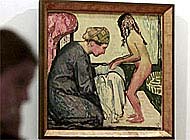
Prolific artist Cuno Amiet on show in Geneva

One of Switzerland's most prolific, yet most misunderstood painters, Cuno Amiet, is the subject of a major exhibition at Geneva's Musée Rath.
The paintings demonstrate the importance of vibrant colour and experimentation in his work.
Amiet, born in Solothurn in 1868, forms a unique bridge between two of the most important movements in art: He was the only artist to belong to both the post-impressionist school of Pont-Aven, set up by Paul Gauguin, and Die Brücke, the Dresden-based movement that laid the foundations for expressionism.
Along with Ferdinand Hodler and Giovanni Giacometti, two painters with whom he was closely associated, Amiet is regarded as one of the pioneers of the Swiss Modernism.
Amiet’s way of experimenting with and blending different styles won him international acclaim at the time, and the 150 or so canvases, many of which date from his most productive period 1892 to 1920, demonstrate his mastery of different techniques.
Yet it is his eclecticism which has been the biggest criticism levelled at his work. Indeed many of the paintings on display look like they could have been painted by Gauguin, Van Gogh or Matisse.
“When he was alive he almost had the status of an official painter. But he probably isn’t as popular as his contemporaries because he always felt throughout his life that he needed to change the way he painted,” says Claude Ritschard, head of 20th century art at Geneva’s Art and History Museum.
“He was never satisfied with his results. He was always trying new techniques and approaches, until he found a way to express his profound nature,” she told swissinfo.
Amiet described himself as a man who explored different paths, and this constant quest for perfection is evident from the many canvases Amiet produced on the same theme.
“Through this exhibition, you can appreciate that building up a body of work is a very difficult process. It also allows someone who is not a painter to better understand the process of creation,” Ritschard says.
Amiet was a student with Giacometti at the Munich Academy and the Académie Julian in Paris. Their training was very traditional, with much emphasis on preliminary sketches and perspective.
“Many young artists at the time tried to find new ways of painting, and Amiet was very much concerned with colour. He tried to express everything through colour and texture. It makes his work very sensitive and sensual,” Ritschard says.
A theme that runs all through Amiet’s work is that of nature, and man’s relationship with it. He drew a great deal of inspiration from the landscape around his home in Oschwand, in canton Berne.
One of his greatest works, Young Girls in Yellow, is typical of this concern with nature and his need to seek new ways of expressing himself. Over several years he re-visted the same subject until the girls had merged into the field of flowers in which they are sitting.
The exhibition, Cuno Amiet: From Pont-Aven to Die Brücke, is at the Musée Rath in Geneva until January 7.
by Roy Probert

In compliance with the JTI standards
More: SWI swissinfo.ch certified by the Journalism Trust Initiative




























You can find an overview of ongoing debates with our journalists here . Please join us!
If you want to start a conversation about a topic raised in this article or want to report factual errors, email us at english@swissinfo.ch.